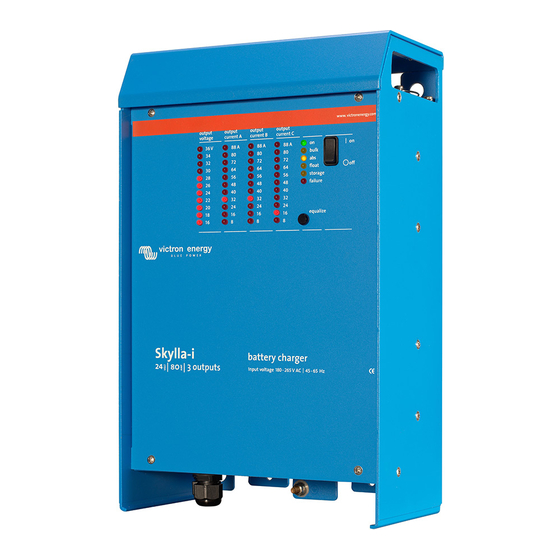
Advertisement
Advertisement
Table of Contents

Summarization of Contents
1. SAFETY INSTRUCTIONS
1.1. General
General safety precautions and usage guidelines for the product.
1.2. Installation
Guidelines for proper and safe installation of the equipment.
1.3. Transport and storage
Instructions for handling the product during transport and storage.
2. INSTALLATION AND WIRING
2.1. Installation
Steps and considerations for physically mounting the charger unit.
Connecting earth
Instructions on how to properly ground the unit according to safety standards.
2.2. Connecting the batteries
Instructions and recommendations for connecting the batteries to the charger.
2.2.1. Connecting the starter battery
Specific instructions for connecting the starter battery to the charger.
2.2.2. Battery connection sequence
The correct sequence for connecting battery cables to the charger and battery.
2.2.3 Battery disconnection sequence
The correct sequence for safely disconnecting battery cables from the charger.
2.3. Other options
Details on connecting external sensors, switches, and relays.
2.3.1. External voltage sensor
Connecting an external voltage sensor for accurate battery voltage measurement.
2.3.2. External temperature sensor
Connecting an external temperature sensor for temperature-compensated charging.
2.3.3. Remote on/off
Wiring instructions for the remote on/off functionality.
2.3.4. Alarm relay connections
Information on connecting the alarm relay for fault indication.
2.3.5. CAN bus connection (VE.Can)
Connecting to the CAN bus for control and communication with other devices.
2.3.6. Synchronised parallel operation
Instructions for synchronizing and operating multiple chargers in parallel.
2.3.7 Connecting the mains
Instructions for connecting the AC mains power cable to the charger.
3. CONTROL AND ADJUSTMENT
3.1. Rotary switch
Selection of preset battery types using the rotary switch.
3.2. DIP switch
Configuration options for the charger using DIP switches.
3.3. Explanation of settings
Detailed explanation of the various DIP switch settings and their functions.
DS-1. Automatic equalization
Explanation of the automatic equalization function and its behavior.
Rotary switch position 8: manual setting potentiometers
Using potentiometers for manual adjustment of charge current and voltage.
Rotary switch position 9: DC power supply mode
Operating the charger as a DC power supply with adjustable voltage.
3.4. Temperature compensation
How temperature affects charging and the use of temperature compensation.
3.5. Manual equalize function
Activating the manual equalization function using the equalize button.
3.6. Power Control - maximum use of limited shore current
Setting a maximum input current limit for the charger.
4. OPERATION
4.1. Battery charging
General overview of the battery charging process and LED indications.
4.2. Seven stage charge curve for lead-acid batteries
Visual representation of the seven-stage charging curve for lead-acid batteries.
4.2.1. Bulk
Description of the bulk charging phase, including voltage and current application.
4.2.2. BatterySafe
Explanation of the BatterySafe feature for preventing excessive gassing.
4.2.3. Absorption
Description of the absorption charging phase, operating in constant voltage mode.
4.2.4. Automatic equalization
Explanation of the automatic equalization phase following absorption.
4.2.5. Float
Description of the float charging phase to maintain battery charge.
4.2.6. Storage
Description of the storage charging phase for long-term non-use.
4.2.7. Weekly battery 'refresh'
Explanation of the weekly battery refresh cycle to maintain battery health.
4.3. Four stage charge curve for Lithium Iron Phosphate (LiFePo4) batteries
Description of the four-stage charging curve for LiFePo4 batteries.
4.3.1. Bulk
Bulk charging phase for Lithium Iron Phosphate (LiFePo4) batteries.
4.3.2. Absorption
Absorption phase for Lithium Iron Phosphate (LiFePo4) batteries.
4.3.3. Storage
Storage phase for Lithium Iron Phosphate (LiFePo4) batteries.
4.3.4. Weekly battery 'refresh'
Weekly refresh cycle for Lithium Iron Phosphate (LiFePo4) batteries.















Need help?
Do you have a question about the Skylla-i 24/100 (1+1) and is the answer not in the manual?
Questions and answers